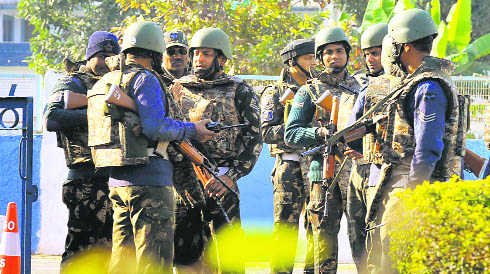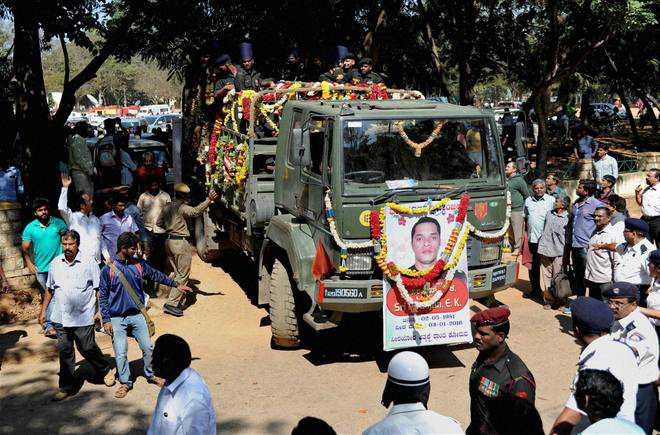Ajay Banerjee,Tribune News Service,New Delhi, January 5
In what appears to be a serious lapse on the part of the security establishment, the command of the operation to flush out terrorists from the Air Force base at Pathankot was changed thrice. It has emerged that at least three officers of the Army, IAF and the National Security Guard headed the operation at different stages. Sources said a review was being carried on this.When the planning to counter the terrorists started in Delhi around 1 pm on January 1 —14 hours before the first shots were fired in Pathankot at 3:30 am on January 2 — two columns of the Army were rushed to Pathankot. Around 1 am on January 2, two-and-a-half hours before the terrorists struck, an NSG team from Gurgaon landed at IAF base. Around mid-morning, the Western Air Command Chief, Air Marshal SB Deo, landed in Pathankot to “oversee” the operation. The Director General of NSG, RC Tayal, arrived in the evening and “oversaw” the operation in coordination with the IG (Operations), NSG. It was amid this confusion and rush to make claims that Union Home Minister Rajnath Singh was “wrongly informed” that the operations were over on January 2 evening. The minister tweeted so, only to delete the message a few hours later. Among the questions being probed are whether the terrorists had a hideout in Punjab. Sources said since it has been established that the six terrorists were on Indian soil by 12:30 am on January 1 (when the first of the four calls were made to Pakistan), they could not have roamed around on the streets carrying over 40 kg of bullets, 30 kg of RDX, guns and grenades for 26 hours when they attacked the IAF base. Another question is how the BSF “failed in securing an unfenced portion on the right bank of the Ujh near Bamyal village in Punjab and who owns this land.Another unusual thing was why the NSG, and not the Army, was told to carry out the operation when the “black cat” commandos are largely trained for urban combat such as the Mumbai attacks.300 NSG: commandos took part in the Pathankot operation160 commandos: flew from Palam military airbase to the attack site on January 170 ‘black cats’: each of two more units reached the IAF base on January 2, 31commando: (bomb squad chief Lt Col EK Niranjan) was killed21other: commandos suffered minor and major injuriesBury slain terrorists in pigskin: Tripura Guv New Delhi: In remarks that could kick up a row, Tripura Governor Tathagata Roy said bodies of terrorists should be wrapped in pigskin and then buried. “I seriously suggest Russian treatment to terrorists’ carcasses. Wrap them in pigskin, bury them face down in pig excreta.””Modi’s chai with Sharif cost us 7 soldiers: SenaMumbai: “India has sacrificed seven of its brave soldiers for Prime Minister Narendra Modi’s tea with Pakistan’s Prime Minister Nawaz Sharif,” the Shiv Sena said in an editorial in party mouthpiece Saamna on Monday. The Sena is critical of Modi’s engagement with Sharif. Kerala institute named after NSG officer Thiruvananthapuram: Hours after the last rites of NSG officer Lt Col EK Niranjan, Kerala’s labour department renamed the industrial training institute in his hometown Elumbulsherry in his honour. The ITI was opened in September last and was named Elumbulsherry Government ITI.
NSG Lt Col buried with full military honours
Tribune News Service,Bengaluru, january 5
The body of Lt Col EK Niranjan, killed while defusing a bomb at the Pathankot IAF base, was today laid to rest at his ancestral village Elambulassery in Palakkad district of Kerala.The body of the 34-year-old was buried on the premises of his paternal home amid chanting of ‘Hare Rama Hare Krishna’ by his close relatives and others present.Niranjan was accorded full military honours, including a 21-gun salute.“The Last Post played on the bugle brought a lump in the throat of many of those attending the funeral,” Kerala Home Minister Ramesh Chennithala said over phone. Earlier in the day, the body was kept at the local school for the people to pay homage.The Kerala government has also renamed the ITI at Lt Col Niranjan’s village after the martyr.Man held for FB postThiruvananthapuram: A 24-year-old man was on Monday arrested in Malappuram district (Kerala) for allegedly making derogatory remarks on Facebook against Lt Col EK Niranjan and his family. Anwar Sadhik was booked under IPC 124 (A) (sedition). A casual labourer at a local shop, he posed as a journalist with a regional daily. pti
BSF conducts search, says no hint yet of infiltration
Shaurya Karanbir Gurung,Tribune News Service,New Delhi, January 5

Border Security Force Director General DK Pathak today reached Gurdaspur to supervise the fourth day of a search near the Ujh river for clues and evidence to suggest that the terrorists who attacked the Pathankot Air Force Station had infiltrated through the International Border with Pakistan.The BSF suspects a possible entry route of the terrorists through the area near Ujh, which also passes by Bamyal village, about 25 km from Pathankot. A BSF post is located ahead of the village.The BSF is also searching along the banks of the Ravi river and the areas around it.“We are looking at other possibilities such as tunnels having been constructed under the IB or underwater means to cross the border through the Ujh and Ravi rivers, which meander into Pakistan from India. But as it is not the monsoon season, the depths of the rivers are a few feet,” said a BSF officer.The officer said tell-tale signs such as fencing being cut, footprints, bending of the grass or an item left behind have not been found. “There were also no Intelligence alerts about any infiltration,” said a BSF officer.There is fencing along the IB in this area, but not in the nullahs (stream). The BSF has instead constructed posts, placed “adequate” manpower and surveillance equipment such as Hand Held Thermal Imagers (HHTIs) on the Ujh’s banks. “It is not possible for heavily armed terrorists to infiltrate through this area,” said the officer. Following the Dinanagar terrorist attack last July, the BSF had increased its deployment along the IB in Gurdaspur. This includes an additional battalion and seven training companies, consisting of more than 2,400 men.The BSF is planning to procure 300 more HHTIs, including for deployment along the IB. Another surveillance equipment used by the BSF in Punjab is the Battle Field Surveillance Radar.Possible entry routeThe BSF suspects a possible entry route of the terrorists through the area near Ujh, which also passes by Bamyal village, about 25 km from Pathankot. A BSF post is located ahead of the village.


